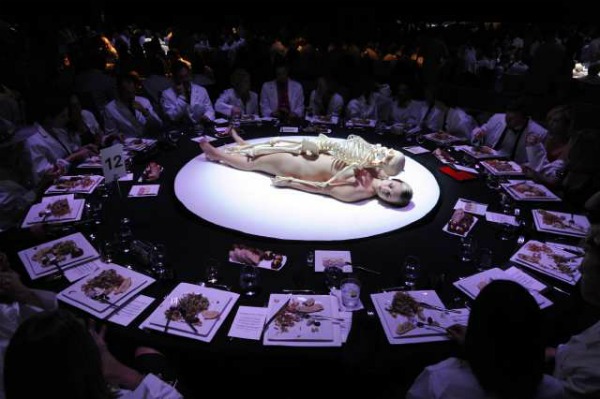The next time you invite potential donors to a fundraiser for your new arts project, consider making a centrepiece of naked dancers.
That’s what Marina Abramovic – “the most influential performing artist working today,” according to MOCA Director Jeffrey Deitch – did for a 2011 gala that raised $2.5 million for Los Angeles’ Museum of Contemporary Art. The event, which the L.A. Times described as “epic,” drew politicians, Hollywood types, and fashionistas who slurped their Kumamotos and gobbled up slices of cake in the shape of Abramovic’s body parts, while ogling live dancers bizarrely posed in various states of undress on top of each dinner table.
A professional dancer, Sara Wookey, who auditioned to perform as a centrepiece then turned down the measly $150 wage, denounced the event as degrading to dancers, and the firestorm around the issue has not abated three years after the event.
Choreographer Yvonne Rainer was aghast:
I myself have never been averse to occasional epatering of the bourgeoisie. However, I can’t help feeling that subjecting her performers to possible public humiliation and bodily injury from the three-hour endurance test at the hands of a bunch of frolicking donors is yet another example of the Museum’s callousness and greed and Ms Abramović’s obliviousness to differences in context and some of the implications of transposing her own powerful performances to the bodies of others. An exhibition is one thing—again, this is not a critique of Abramovic’s work in general—but titillation for wealthy donor/diners as a means of raising money is another.
Abramovic defended herself and dismissed the accusations:
When I use my body I use it, I don’t care if I’m now 65 or I’m 15, the body is just the tool to say something and to elevate human experience, not to put it down … she [Rainer] doesn’t see the poetry of the whole thing, she doesn’t see all the layers of meaning… art has to ask questions… has to be disturbing…
Dancers who are perennially scrambling to meet next month’s rent might be excused for not seeing “the poetry” in all this.
Today, a tempest swirls over the Free People advert, in which an amateur ballerina attempts to haul herself up on pointe while clad in the gauzy scraps that pass for fashion these days. Free People has since attempted to silence the howls by “re-launching” its new FP Movement line with fashion photos of real, professional dancers.
Which calls to mind the scandal over the hiring of Natalie Portman to portray a crazed ballerina in the ghastly thriller Black Swan. The producers’ misguided decision to hire a big-name actress over one of many dramatically trained ballerinas was compounded by their failure, and Portman’s, to properly credit the critical role played by Portman’s body double, Sarah Lane of American Ballet Theatre. Portman and her director, Darren Aronofsky, claimed that she did indeed do much of the dancing that appeared on screen, but knowledgeable balletomanes recognized immediately that Portman’s awkward, amateurish port de bras (carriage of the head, shoulders and arms) meant it was impossible for her to have executed any of the full-body movements choreographed by Benjamin Millepied (who, conveniently for everyone on Team Portman, quickly became Mr. Natalie Portman.)
Why do dancers continue to suffer these indignities? Is it because they are unaccustomed to speak up for themselves, because they are trained to communicate with their bodies rather than their voices?
Dancers’ unions are generally much weaker than musicians’ and stagehands’ unions, because dancers often refuse to strike, thus weakening their bargaining position at the negotiating table. They are sensitive to the fact that their careers are fleeting, and they are so used to competing for every additional moment onstage, that refusing to dance for any reason seems like sheer folly to them.
And just in case you think dancers who make it into the top dance companies are financially secure, you may be right – if you live in Europe or Russia, where dancers are treated like civil servants. Otherwise, dancers are typically under contract for no more than 32 weeks – with most companies’ rehearsal and performance seasons far shorter than that. Dancers typically earn between $500 to $2,000 a week, and rely on guest appearances in the off-season to make ends meet. It is the rare dancer who scores a commercial opportunity or endorsement (like Misty Copeland for Under Armour.) Saving for the future is a challenge, with women’s careers typically over by 40 and men’s by 45, though injury can finish them off earlier.
It is reasonable for a struggling, little-known artist to ask dancers to participate in new work for modest compensation; and dancers have the freedom to volunteer for projects that they find interesting.
But for the powerful and successful to literally serve up naked dancers’ bodies on a dinner table as part of a strategy to entice the wealthy diners to fork over cash is tasteless and exploitative. Abramovic might as well have held the fundraiser at a strip club. Though I understand those performers earn a living wage.









And now Coca Cola is hastily trying to undo the damage from its latest foray into the flash mob scene, for which it advertised for dancers whom it was offering to pay with free soft drinks: http://www.thestage.co.uk/news/2014/06/coca-cola-forced-u-turn-unpaid-dancers-plan/
Satisfying news from the Guggenheim Museum that we hope will set a precedent: http://www.nytimes.com/2015/07/31/arts/design/looking-at-how-performers-are-paid-for-performance-art.html?mwrsm=Facebook